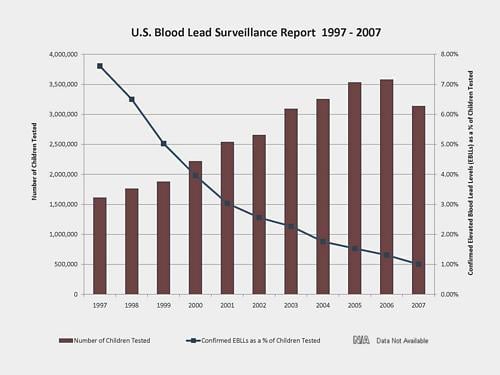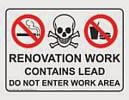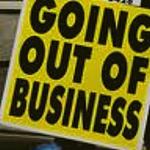Does Economy Buster RRP Have Any Factual Basis?
One Person’s Opinion: This is a guest blog submitted by Ray Douglas to express his opinion. Ray is a remodeling contractor in Brodhead, Wisconsin and has been in business for 34 years. He comments and contributes to RRPedia quite often. If you would like to express your opinion or offer something of value for RRPedia visitors let me know.
Does Economy Buster RRP Have Any Factual Basis
If lead dust from remodeling is the main reason for elevated blood lead levels (EBBL’s) in children, then why did EBBL’s in children drop dramatically during the same ten year period (1997-2007) that remodeling activities doubled? The CDC and Harvard University Joint Center for Housing Studies charts below show this.


In a recent blog, the question was asked of the Director of Massachusetts’ Childhood Lead Poisoning Prevention Program; “How many children in Massachusetts were poisoned by lead due to renovation?” The answer: “He had no idea and said the Commonwealth doesn’t track the source of the poisoning.”
A Mercatus Reports article written by Alastair Walling in 2006 states: “Even though the details of their own studies show little in the way of a link between R&R work and elevated blood lead, the EPA is persisting with its planned certification of R&R workers. The proposed rules may not produce lower blood-lead levels, but they will raise the cost of renovation and remodeling.”
In a letter dated 11-27-2009, written by SBA Office of Advocacy that was sent to EPA administrator Jackson, makes the following statement: “Advocacy believes that the evidence in fact shows that private contractors (i.e., professional renovators) subject to reasonable cleanup standards, including the “no visible dust or debris” standard, do not create additional health hazards.”  When you remove all the smoke and mirrors from this rule, the EPA can prove two thoughts; 1 Some remodeling activities create dust 2 Lead paint dust can create or raise EBLL’s Independent of each other those two statements can be proven, but the combination (which is a major foundational reason for RRP) is not so clear. Why?
When you remove all the smoke and mirrors from this rule, the EPA can prove two thoughts; 1 Some remodeling activities create dust 2 Lead paint dust can create or raise EBLL’s Independent of each other those two statements can be proven, but the combination (which is a major foundational reason for RRP) is not so clear. Why?
The EPA admits there are several other sources of lead exposure. These include lead in soil, water, toys, glassware etc. The following links provide some examples:
- All Lead Recalls Posted By the CDC
- Congressional Report Prompts Fear and Anger Over Lead In D.C. Water
If it was suspected that a child got EBBL’s from a remodeling activity, were all the other possibilities of lead exposure ruled out? Was everything that the child touched or ingested also tested? That would almost be impossible to do. However, by not doing so, how can it be proven that any lead dust generated by responsible remodelers is a leading cause of EBBL’s in children?
If the EPA had confidence in the RRP rule, why didn’t they add the following statement inside the RRP Renovate Right pamphlet:
“The contractor, by following these rules, will contain all the lead dust he/she created doing your project, and cannot be held liable for any other past, present or future lead contamination or exposure.”
Because of the extra costs, and the lack of consumer awareness about the dangers of lead, this rule is a tough sell to the customer. It becomes an even tougher sell when the customer asks for evidence to justify the rule. As discussed above, there is a lot of information that questions the need for it. So, unfortunately, the best answer a contractor may be able to offer is “because it’s the law”.  Since I can’t explain to the customer the need for this rule, I encourage my customers and prospects to contact their state and federal representatives and ask them to provide facts and figures to explain the need for the RRP rule. To assist them with this, I supply them with a letter to send to their representatives along with a stamped and addressed envelope. I encourage all other contractors to consider doing the same.
Since I can’t explain to the customer the need for this rule, I encourage my customers and prospects to contact their state and federal representatives and ask them to provide facts and figures to explain the need for the RRP rule. To assist them with this, I supply them with a letter to send to their representatives along with a stamped and addressed envelope. I encourage all other contractors to consider doing the same.
To make sending the letters easier, Shawn and I have created sample letter templates that can be shared with and used by remodeling customers and concerned homeowners. There is a sample contractor letter available as well. Click here to view or download the letter templates. Special thanks to Melanie Hodgdon of Business Systems Management for helping edit the letters and for suggesting some of the content of the letters.

 Looking for accurate information about the EPA RRP rule?
Looking for accurate information about the EPA RRP rule? 
 A
A  Perhaps industry trade associations can take advantage of this executive order to get EPA to rethink the current RRP rule. To protect the interests of renovators, at a minimum, the RRP Rule or any proposed amendments should reflect real scientific facts about EBLL’s caused by RRP activities and address the economic challenges currently being experienced by compliant businesses that have been complaining about illegal and unfair completion due to the lack of enforcement of the RRP Rule by EPA.
Perhaps industry trade associations can take advantage of this executive order to get EPA to rethink the current RRP rule. To protect the interests of renovators, at a minimum, the RRP Rule or any proposed amendments should reflect real scientific facts about EBLL’s caused by RRP activities and address the economic challenges currently being experienced by compliant businesses that have been complaining about illegal and unfair completion due to the lack of enforcement of the RRP Rule by EPA.  Although their primary purpose is to represent and protect their members, the efforts of these trade associations also benefit remodelers and therefore should be recognized. I thought this would be a good opportunity to recognize some of these associations. The list below is by no means complete as I am sure there are many other associations contributing as well. If I have missed any that you know of please name them by posting a comment below. I will add them to the list in the body of this article as I am made aware of them.
Although their primary purpose is to represent and protect their members, the efforts of these trade associations also benefit remodelers and therefore should be recognized. I thought this would be a good opportunity to recognize some of these associations. The list below is by no means complete as I am sure there are many other associations contributing as well. If I have missed any that you know of please name them by posting a comment below. I will add them to the list in the body of this article as I am made aware of them. Two recent efforts by trade associations recently came across my attention. One was by the National Association of the Remodeling Industry (NARI). In a
Two recent efforts by trade associations recently came across my attention. One was by the National Association of the Remodeling Industry (NARI). In a  I suggest that the two letters contain some very good points and are well written. Renovators with similar concerns could, using the content of these two letters as a reference, write to their own local politicians and or to EPA to express their concerns and demand that EPA recognize the challenges small businesses are having as a result of the rule as well as EPA’s lack of adequate administration and enforcement of the rule.
I suggest that the two letters contain some very good points and are well written. Renovators with similar concerns could, using the content of these two letters as a reference, write to their own local politicians and or to EPA to express their concerns and demand that EPA recognize the challenges small businesses are having as a result of the rule as well as EPA’s lack of adequate administration and enforcement of the rule.
 “Number of events and individuals affected: In the first year that all of the rule requirements will be in effect, there will be an estimated 8.4 million renovation, repair, and painting events where lead-safe work practices will be used due to the rule. As a result, there will be approximately 1.4 million children under the age of 6 who will be affected by having their exposure to lead dust minimized due to the rule. There will also be about 5.4 million adults who will be affected. After improved test kits for determining whether a painted surface contains lead-based paint become available (which is assumed in the analysis to occur by the second year of the rule), the number of renovation, repair, and painting events using lead-safe work practices is expected to drop to 4.4 million events per year. No change in the number of exposures avoided due to the rule is expected because the improved test kit will more accurately identify paint without lead, thus reducing the number of events unnecessarily using the required work practices.”
“Number of events and individuals affected: In the first year that all of the rule requirements will be in effect, there will be an estimated 8.4 million renovation, repair, and painting events where lead-safe work practices will be used due to the rule. As a result, there will be approximately 1.4 million children under the age of 6 who will be affected by having their exposure to lead dust minimized due to the rule. There will also be about 5.4 million adults who will be affected. After improved test kits for determining whether a painted surface contains lead-based paint become available (which is assumed in the analysis to occur by the second year of the rule), the number of renovation, repair, and painting events using lead-safe work practices is expected to drop to 4.4 million events per year. No change in the number of exposures avoided due to the rule is expected because the improved test kit will more accurately identify paint without lead, thus reducing the number of events unnecessarily using the required work practices.”
 It would seem from reading the above text that EPA did not listen to the many commenters who sited additional costs well beyond EPA’s estimated average additional cost of $35.00. The text also shows that the EPA rationalized that consumers would not be inclined to avoid working with a certified firm based on such a small price difference. Was their math wrong? Are they oblivious to the real costs reported by those doing the work now that the rule is in place? Have they done any research to determine if the rule has had any unintended consequences? Or, are they willfully ignoring the true realities and effects of the additional costs to comply?
It would seem from reading the above text that EPA did not listen to the many commenters who sited additional costs well beyond EPA’s estimated average additional cost of $35.00. The text also shows that the EPA rationalized that consumers would not be inclined to avoid working with a certified firm based on such a small price difference. Was their math wrong? Are they oblivious to the real costs reported by those doing the work now that the rule is in place? Have they done any research to determine if the rule has had any unintended consequences? Or, are they willfully ignoring the true realities and effects of the additional costs to comply? Don’t get me going about the “Small added costs” and that the EPA plans to “encourage” consumers to choose only contractors who are Lead-Safe Certified. Wouldn’t it have made sense and have helped those businesses complying with the rule to have done the outreach and education before and as the rule went into effect? Wouldn’t have made sense to “require” consumers choose only contractors who are Lead-Safe Certified?
Don’t get me going about the “Small added costs” and that the EPA plans to “encourage” consumers to choose only contractors who are Lead-Safe Certified. Wouldn’t it have made sense and have helped those businesses complying with the rule to have done the outreach and education before and as the rule went into effect? Wouldn’t have made sense to “require” consumers choose only contractors who are Lead-Safe Certified? How bad is the child lead poisoning problem? And, how many of the poisoned children were poisoned by lead due to renovation work? The answer to these two simple questions might surprise you. Had the EPA and Congress done adequate research, might they have found better and more cost effective ways to further reduce the number of lead poisoned children?
How bad is the child lead poisoning problem? And, how many of the poisoned children were poisoned by lead due to renovation work? The answer to these two simple questions might surprise you. Had the EPA and Congress done adequate research, might they have found better and more cost effective ways to further reduce the number of lead poisoned children?  No child should be poisoned by lead. However, our government and politicians are concentrating in the wrong area if they really want to substantially address the lead poisoning problem. As I had discussed in a
No child should be poisoned by lead. However, our government and politicians are concentrating in the wrong area if they really want to substantially address the lead poisoning problem. As I had discussed in a 


 The recent RRP rule requires contractors to follow certain lead-safe work practices to protect homeowners, their families and the workers who perform work where lead paint is or might be present. The rule also requires training of workers to be sure they know how to do the work, protect themselves and stay in compliance with the rule. Lead poisoning is a real issue. Protecting people from the dangers of lead is the right thing to do. Although we may all have our own opinions about the actual rule itself, as an industry and as professionals, we must do what is right.
The recent RRP rule requires contractors to follow certain lead-safe work practices to protect homeowners, their families and the workers who perform work where lead paint is or might be present. The rule also requires training of workers to be sure they know how to do the work, protect themselves and stay in compliance with the rule. Lead poisoning is a real issue. Protecting people from the dangers of lead is the right thing to do. Although we may all have our own opinions about the actual rule itself, as an industry and as professionals, we must do what is right. Many businesses, ranging from remodelers, subcontractors, manufacturers, distributors, vendors, trainers and even trade associations have contacted me to express their disappointment with EPA’s handling of this rule since it took effect on April 22, 2010. Although EPA claims to have done extensive outreach to consumers and the regulated community, the results of their efforts have proven to be ineffective. Enforcement of the rule so far has been almost non-existent, particularly in light of the number of non-compliant businesses still doing the work in ways that are definitely poisoning our children, their families and those workers who perform renovations where lead is present. The EPA’s June announcement regarding their decision to delay enforcement of the training and firm certification requirements was interpreted by many renovators as a delay of the whole rule, not just the fines for such violations. As a result, many businesses trying to support renovators in complying with the rule have reported that sales have dropped to the point where they must consider shutting down. I could go on with my list but I am probably preaching to the choir.
Many businesses, ranging from remodelers, subcontractors, manufacturers, distributors, vendors, trainers and even trade associations have contacted me to express their disappointment with EPA’s handling of this rule since it took effect on April 22, 2010. Although EPA claims to have done extensive outreach to consumers and the regulated community, the results of their efforts have proven to be ineffective. Enforcement of the rule so far has been almost non-existent, particularly in light of the number of non-compliant businesses still doing the work in ways that are definitely poisoning our children, their families and those workers who perform renovations where lead is present. The EPA’s June announcement regarding their decision to delay enforcement of the training and firm certification requirements was interpreted by many renovators as a delay of the whole rule, not just the fines for such violations. As a result, many businesses trying to support renovators in complying with the rule have reported that sales have dropped to the point where they must consider shutting down. I could go on with my list but I am probably preaching to the choir. Second, if you have suggestions, contacts and or the means to assist me in distributing this information to those who can help us with this important issue, please let me know. Anyone is welcome to leave comments here at the end of this blog. However, I would prefer that you e-mail me your thoughts in letter-like form and that you include your complete contact information as well as your permission to use and distribute what you send me. I will not redistribute information from anonymous parties.
Second, if you have suggestions, contacts and or the means to assist me in distributing this information to those who can help us with this important issue, please let me know. Anyone is welcome to leave comments here at the end of this blog. However, I would prefer that you e-mail me your thoughts in letter-like form and that you include your complete contact information as well as your permission to use and distribute what you send me. I will not redistribute information from anonymous parties. Renovators should be aware that in addition to EPA or administering states, other individuals or entities may likely take advantage of the documentation requirements to hold renovators accountable for their actions or lack thereof.
Renovators should be aware that in addition to EPA or administering states, other individuals or entities may likely take advantage of the documentation requirements to hold renovators accountable for their actions or lack thereof. OSHA could use RRP paperwork to prove non-compliance with its Lead in Construction Standards. OSHA’s worker protection requirements related to lead are very specific. Information contained in the required RRP documentation, particularly the renovation checklist and non-certified worker training documentation, could easily be used to show workers were not adequately trained and or protected when working in contained work areas. A lack of the required documentation could also be used by OSHA to demonstrate negligence by the business.
OSHA could use RRP paperwork to prove non-compliance with its Lead in Construction Standards. OSHA’s worker protection requirements related to lead are very specific. Information contained in the required RRP documentation, particularly the renovation checklist and non-certified worker training documentation, could easily be used to show workers were not adequately trained and or protected when working in contained work areas. A lack of the required documentation could also be used by OSHA to demonstrate negligence by the business. 


